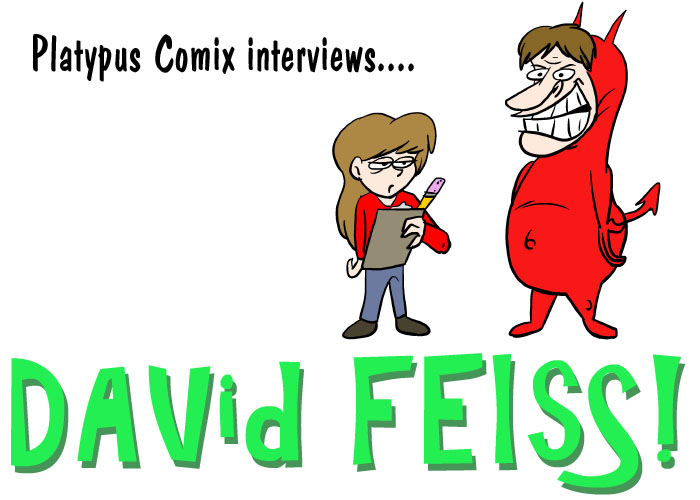

Cartoonist and animator David Feiss has a long resume, but is most known for creating one of the original Cartoon Cartoons, Cow and Chicken, as well as its short-lived spinoff I Am Weasel. Mild-mannered reporter John Pannozzi sat down recently with Feiss to discuss the joys of having 1 1/2 of your cartoon shows on the air, his experiences all over the animation industry, and what it's like living across the street from Flava Flav.
John Pannozzi: What was your family
like when you were growing up? How many siblings did you have?
David Feiss: I had a pleasant family life--There was a lot of
drawing going on in my house. My mom always had plenty of paper
and pens to create with. My cousin Sam Kieth, who went on to
great comic fame, was almost always at our house while I was
growing up--we spent thousands of hours drawing at my parents
dining table. I am the oldest of 3 children--I have two sisters,
Lois and Cathy.
JP: What did you do in high school?
DF: I painted a lot in high school--oil on canvas--I fancied
myself a fine painter, tending towards photo-realism, not at all
like what I was doing with my cartoons. I also made many 8mm
animated films during this time.
JP: How did you get to work for Hanna-Barbera back in the
late 1970s, while still a teenager?
DF: All of my earlier animated films were made with my parents
old 8mm movie camera that had no sound- so, I figured I would
need sound on my films to get a job in Los Angeles at the
studios. I bought a super 8 sound camera with single-frame
capabilities, and made my first sound cartoon: "Maxwell's
Silver Hammer" by the Beatles (I animated to the song) So,
at age 19, I brought the finished film to Hanna-Barbera, also
lugging my 8mm sound projector with me, guessing that a real
studio would not have one. I projected the movie against the wall
of Hanna-Barbera's recruiter, Harry Love. He called in Iwao
Takamoto, H-B's lead executive, who hired me that very day.
JP: What was the first thing you worked on when you first
arrived at H-B?
DF: I was mentored by Ken Mundie (who designed and animated the
titles for the 1960's TV series "Wild Wild West") He
had me animating on a title sequence for a live action movie
called "C.H.O.M.P.S."
JP: Did you share the depression that many others in the
animation industry felt around the 1970s and early-to-mid 80s
regarding the quality of the work that was being made?
DF: Absolutely. I mean I was very happy to have the opportunity
to be animating professionally, I was aware that the art level
was pretty low.
JP: Of all the shows you’ve worked on over the
years, are there any you remember offhand that aren’t
included on your IMDB filmography?
DF: There are many many TV commercials I animated on over the
years that aren't listed--I worked for Colossal Pictures in San
Francisco in the early 90's, later for Wildbrain, as well as TV
commercials for Canada out of Bear Spots/Nelvana.
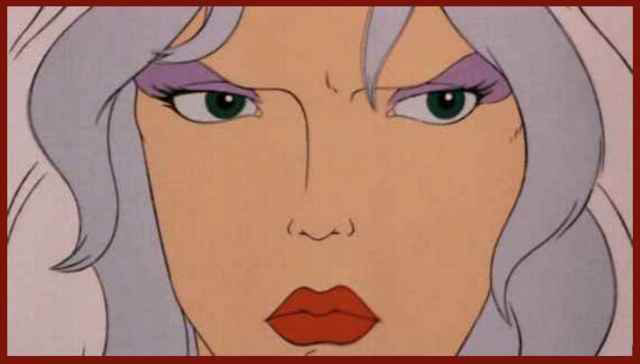
JP: Tell me a little bit about working
on the Taarna segment of the 1981 Heavy
Metal animated movie. I know work on that
movie was split between studios in the USA, the UK, and Canada.
What animation house did you work at during the making of Heavy
Metal and where was it located? Also, what
scenes did you animate for the Taarna segment?
DF: I was living and working in Toronto at a Hanna-Barbera
sub-contract studio called Canimage. We were animating
Scooby-Doo. When that job ended, Canimage made a deal to take on
the internationally animated feature "Heavy Metal". Our
sequence came out of a studio in Montreal.
It ended up being my first feature animating experience. I really
don't remember what I animated--lots of short scenes here and
there with some character who had a buzz saw hand, and he was
fighting Taarna, plus some crowd shots that the Montreal studio
probably didn't want to do so they sent them to us!
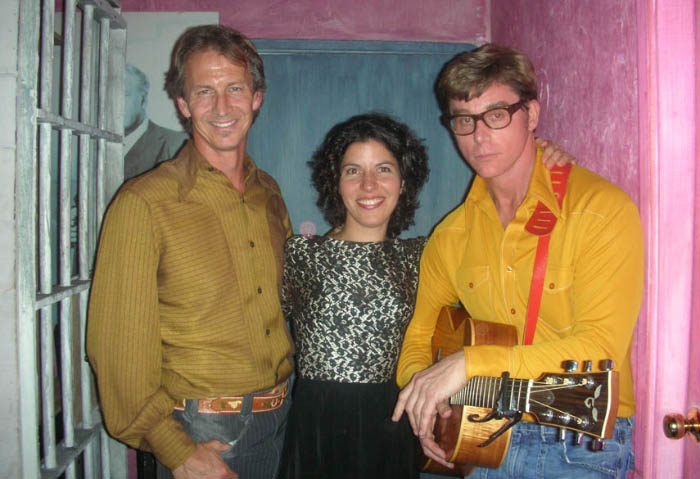
Dave, AnneMarie Ashkar, and John K
JP: How did you first meet John
Kricfalusi, and what do you honestly think of him? What’s it
like to work with him?
DF: I met John for the first time at "Cuckoos Nest" in
Taipei, Taiwan in early 1985. I was sent over by Bill Hanna to
supervise animation on the TV series "The Jetsons", and
John had already been there for 2 months when I arrived. John's
then girlfriend, the talented Lynn Naylor was also supervising.
He was the layout supervisor. We all became good friends. We all
shared an apartment there, and had lively discussions about
everything you can imagine almost every night.
I think John is terrific--probably the most
influential cartoonist of the last 30 years. It was because of
him, and Ren and Stimpy, that creator-driven animated
shows came to pass. Up until then, TV animation was created by
studios, not creative individuals. His show opened the gates for
all the rest of us.
JP: You and John K. both worked on the Jetsons revival in
the 1980s. Tell me about that. I knew John K. went to Taiwan to
work on that show, so did you work directly with him, or even
indirectly (i.e. keeping in touch via phone calls)?
DF: We had a blast. I was living in Spain right before I went to
Taiwan, and I was asked to stop by Los Angeles to check in at H-B
before my flight. I was told about John, about how he was a bit
of a loose cannon, and I should keep my eye on him. But when I
met him, I realized that he was probably the most gifted talent
out there, and loved every minute of our time working together,
and didn't keep my eye on him--the only thing he was trying to
'get away with' was trying to make the shows funnier.
JP: You also worked on the Jetsons movie; tell me about
that, especially what scenes you animated. I have to say that I
have considerable nostalgia for the movie (also the 1980s
episodes) since I watched when I was really young, even if
objectively speaking, the film has a lot of flaws.
DF: I animated quite a lot of that movie, although I remember
only a few--like the "Elroy Elevator" move as he plays
basketball, and Astro's nose sniffing out of control as he sniffs
some furry creature.
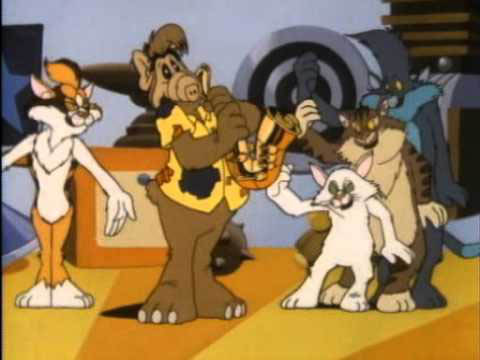
JP: Any memories of working on the Alf
cartoon and its spin-off, Alf Tales?
DF: Richard Raynis brought me in to board, and then he had me
create the opening titles, which ended up being nominated for a
prime-time Emmy (it got beat out by the main title of a soap
opera, "The Bold and The Beautiful"). I was the
director of Alf Tales.
JP: Is IMDB true in stating that you directed the
Canadian animated TV special "The Body Electric," based
off the music of the band Rush, and if so, what’s the story
with that?
DF: An old friend of mine, Don Spencer, recruited me to direct
this 30 minute movie with the music of Rush. The studio was
Atkinson Film Arts, in Ottawa. It was fun, but I don't remember
much else about the film.
JP: I see that you were an animator on The
Chipmunk Adventure. What scenes did you
animate?
DF: I animated quite a few scenes, but the only sequence I
remember was a song with Alvin wearing a huge sombrero, and he
ends up falling into a fountain.\
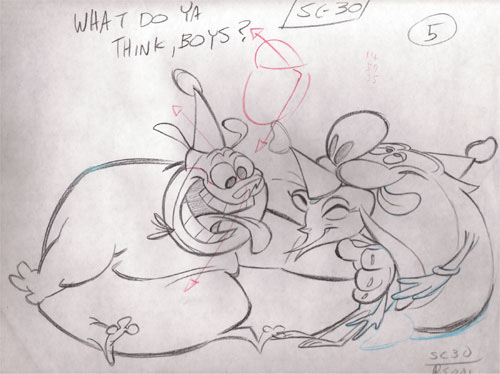
JP: How did you get involved with the Ren
& Stimpy pilot “Big House Blues”?
John K. pointed out a scene you animated for it on his blog, but did you animate any other
scenes, and if so, which?
DF: After leaving Taiwan, John and I kept in touch. So when he
sold the pilot to Nickelodeon, he called me to help animate. I
think that my scenes were all of the bulldog scenes surrounding
the one mentioned in John's blog.
JP: You’re credited as an animation director on the
first two seasons of the original Ren &
Stimpy show. What specific episodes did you
work on?
DF: The one I remember clearly was "Nurse Stimpy”.
JP: Not to get too political, but what’s your
perspective on Nickelodeon’s firing of John K. from Ren
& Stimpy?
DF: I thought it was a big mistake. It was his creation, and he
WAS the show.
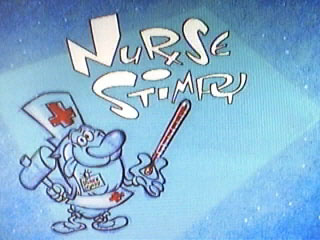
JP: And I hear you did animated
segments for the computer game "The Adventures of Hyperman."
Tell me about that.
DF: That was created by my friends Cliff MacGillvary and Kelly
Ward, and designed by the great Phil Mendez. I think I boarded
the whole thing, plus I did animation for it.
JP: Tell me a little bit about your domestic family: I
see your first wife was Pilar Menendez, with her you had two
children David Jr. and Sara, who inspired the personalties and
relationship of Cow and Chicken; your second wife is Annmarie
Ashkar Feiss, and from her you acquired stepsons Colin, Quinn,
and Morgan and a new son named Harrison. May I ask if you’re
still on good terms with Pilar, and when were David Jr., Sara and
Harrison born and what are they doing now? Also, how much of Cow
& Chicken comes from David Jr. and Sara?
DF: I don't see her at all--she lives in Spain, and I live in Los
Angeles. My oldest, David Miguel [David Sr.’s middle name is
Michael], was born in 1984, is a car salesman....Sara, born in
1988, is working at a cool animation studio in Hollywood called
Six Point Harness, and Harrison was born in 2012, and he's not
working yet!
A lot of Cow and Chicken was based on them, but some stories came from my childhood, too.
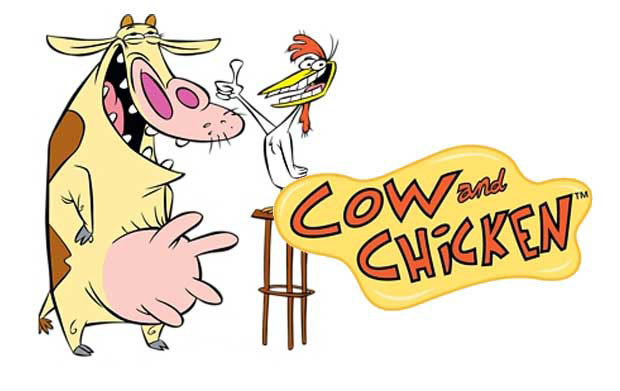
JP: What were you doing right before
you pitched Cow & Chicken
to the What-A-Cartoon project, which I assume happened sometime
in 1994, or was it 1993?
DF: It was 1993, and I was working for Film Roman.
JP: What was it like making the Cow & Chicken pilot
“No Smoking”? Did you make it in H-B’s building,
or elsewhere? I noticed that Pilar and your cousin Sam Kieth
helped write the story; being a big fan of Sam and his comic book
work, I’m curious to know what ideas for the pilot were his,
and what were Pilar’s? Who did storyboards and layouts for
the pilot?
DF: During the pilot, by day I was working for M-G-M on "All
Dogs II" and animating on the pilot at night. It was a
blast--there were not a lot of opportunities to animate an entire
pilot, and I thoroughly enjoyed it. I was living in Sacramento at
that time, and sharing a studio with Sam Kieth. He was busy doing
The Maxx. We constantly were interacting with each other's
projects. Sam was a great sounding board for me, and some of his
contributions to the pilot were pieces of dialogue here and
there, as well as the phrase "Pork butts and taters" as
Chicken's favorite meal. Pilar's contribution was having Supercow
speak only in Spanish.
I did the storyboard, and the layouts and art direction were done by the brilliant Deane Taylor (The Nightmare Before Christmas).
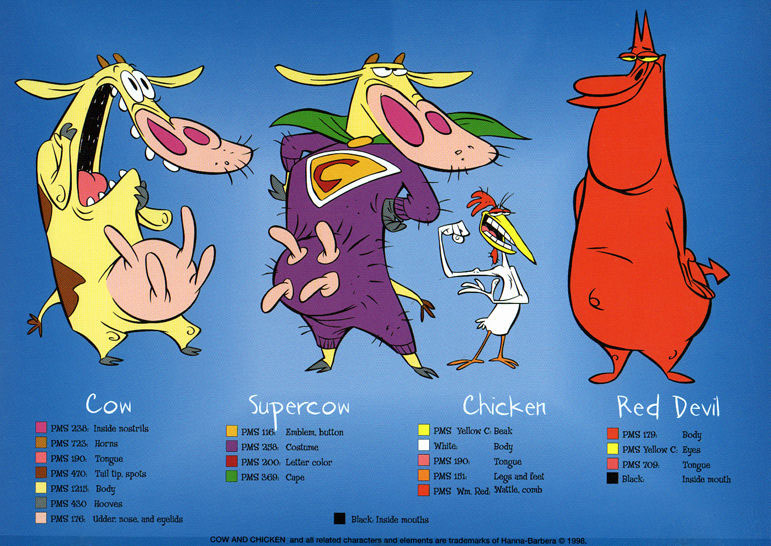
JP: Exactly how did they choose to make
Cow & Chicken into
a series? Did the viewers vote for it, or did higher-ups at the
network like it?
DF: The executives at Cartoon Network liked it, but they also had
viewers vote, too. It came in at number 2. (Van Partible's
"Johnny Bravo" was #1!)
JP: You were an animation director on All
Dogs Go To Heaven 2.
DF: I remember there was a bit of stress on that film, but
artistically I had fun--I boarded a lot, as well as animated
quite a lot, too. I remember [animating] a big song sequence with
the villain devil character, but nothing more specific than that.
I bet I'd remember if I were to see it again.
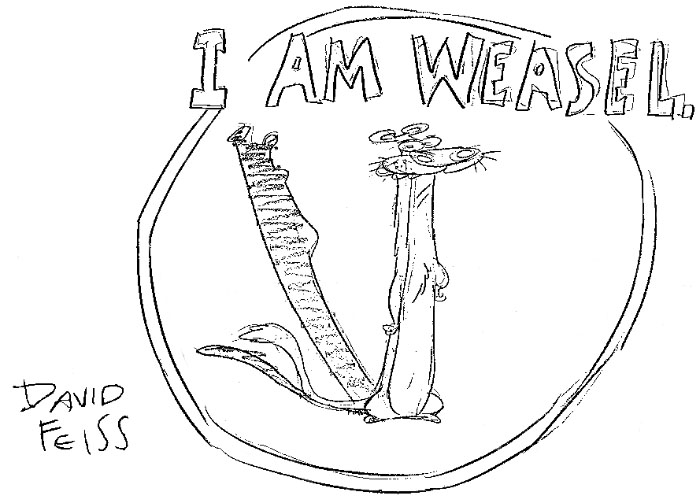
Feiss's very first Weasel drawing
JP: Tell about the inception of I
Am Weasel. IMDB claims that you initially
didn’t want to do more Weasel cartoons after the first
season of Cow & Chicken,
but gave in on the condition that the Red Guy would become the
primary antagonist for that segment. Is this true?
DF: When Cartoon Network ordered Cow and Chicken as a
series, they later decided that they wanted a different cartoon
sandwiched between Cow and Chicken. I was doodling one
day, and drew a weasel, with the title "I Am Weasel",
off of one of my favorite books as a teenager, Richard Matheson's
"I Am Legend." I thought against type, that instead of
a weasel who was a weasel, this guy would be smart and
heroic. Then off of "the monkey and the weasel" kids
song, I created I.R. Baboon, a dumb character jealous of Weasel's
success.
There was a lot of pressure to complete Cow and Chicken quickly, and I felt that I couldn't dedicate enough time to the second show. But Cartoon Network wanted to spin off Weasel, so we did. I don't really remember asking if I could or could not cross populate the two shows--I just did it because it felt like the same universe, plus I thought it was funny to have the Red Guy in I Am Weasel.
JP: Is the lead character from I
Am Weasel actually named I.M. Weasel?
DF: Yes.

JP: I remember seeing a name for Cow
& Chicken’s teacher on the internet a long time ago. Was
this name something invented by you or anyone else involved with
the show?
DF: That I don't remember-- as I far as I can recall, she was
only known as "teacher". She was loosely based on my
4th grade teacher.
JP: How many seasons of Cow &
Chicken were in the works when Fred Seibert
left H-B to form Frederator Studios?
DF: Fred left after the first season.
JP: During Christmas 1997, Warner Bros. closed the H-B
building and moved its productions to their own studios. What
season of Cow & Chicken were you working on at that point?
DF: I think we did season 3 there, as well as I Am Weasel.
JP: What was it like working at the WB studios, where I
assume the rest of Cow & Chicken,
as well as the I Am Weasel spinoff
and the Lost Cat pilot
were produced? Did you work in the Sherman Oaks WB Animation
building, or the WB lot?
DF: I preferred the old H-B building- I started there when I was
19, and it felt like home. We worked out of the Sherman Oaks
galleria building, which wasn't bad, either. I produced [Lost
Cat] at my own studio I had in Northern California.
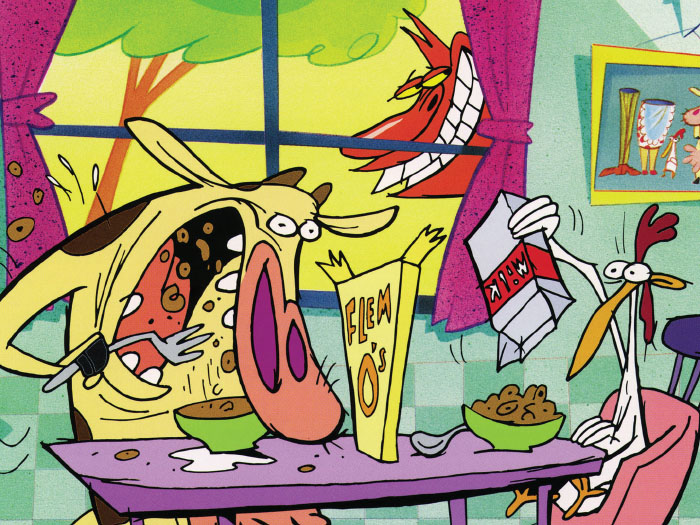
JP: I read in the Cow & Chicken FAQ that there was talk of a Cow
& Chicken movie. Is that true, and if
so, please divulge the details (when it was considered, if any
ideas were conceived for it, when and why it was abandoned, etc.)
DF: There was an outline that Mike Ryan and I (my story editor)
came up with. I'm not entirely sure why it was abandoned. We
could have had fun!
JP: Is it true that David Jr. wrote “Black Sheep of
the Family” uncredited? And while we’re on the topic,
did Cow & Chicken
and I Am Weasel (and
“No Smoking” and “Lost Cat”) use scripts?
DF: He came up with the title, which inspired me to write the
episode, as well as the idea for "Major Wedgie." I
never used scripts, just 2-3 page outlines.
JP: I do remember at least one Cow
& Chicken cartoon had a "Teleplay
by" credit. Where these an exception to your "no
scripts" rule, or there more like in-depth outlines than
flat-out scripts?
DF: I don't remember a "Teleplay" episode- that's
curious…There really wasn't a "no-script rule," it
just naturally happened that way. Some outlines were definitely
more fleshed out than others.
JP: What was it like when Cow &
Chicken ended? Was it at all sad to leave
the characters behind?
DF: Yeah, it was sad. I loved the world, and still have plenty
more ideas for them!
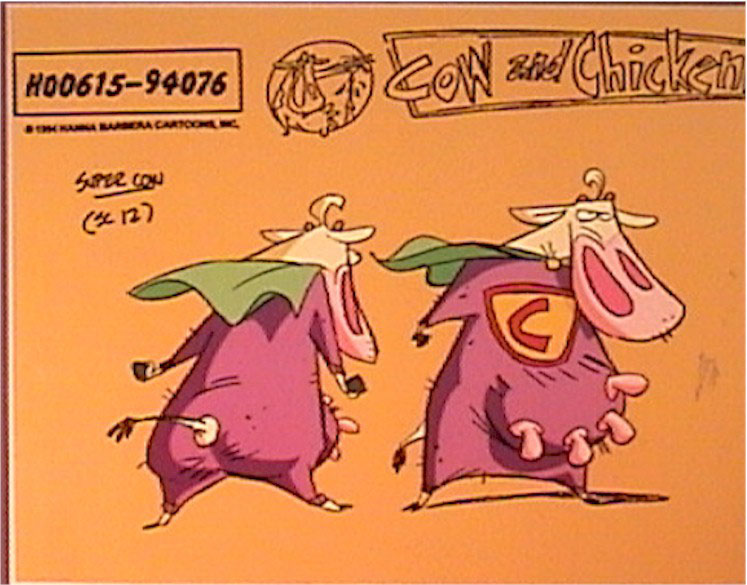
JP: Why did they decide to make a
spin-off of I Am Weasel,
especially since Cartoon Network didn’t have too many
original series back in 1999? And why was there only 9 half-hours
worth of new material made for it, instead of the more standard
13?
DF: Cartoon Network liked the show--and I think there were a
total of 76 seven-minute shorts made.
JP: Tell me a bit about the cartoon pilot you made in
1999, “Lost Cat”. Why wasn’t it made into a
series, and may I ask if the rights to the cartoon, or at least
the characters reverted to you?
DF: My wife at the time suggested that if you had a show called
"Lost Cat", then there was free advertising on
telephone poles in every town. So I came up with this homeless
cat, who would make himself look like the picture on Lost Cat
posters, trying to scam his way into a cushy life. The pilot
ended up being not quite the way I had wanted it to go, and the
network decided not to do a series. I do own it.
JP: Way back in the late 1990s, there was an official Cow
& Chicken website run by you. How/why
did you have a website at a time when very few people in the
animation industry (or the entertainment industry, in general)
were accessible online? Why was the website abandoned (I know
Cartoon Network started their Cow &
Chicken page around summer 2001, which was
I believe about the same time your site disappeared, so was it a
legal issue?)?
DF: Actually, the site was run by my childhood friend, Kurt
Willmon. It was abandoned after Kurt got too busy with his own
business. There never was a legal issue involved.
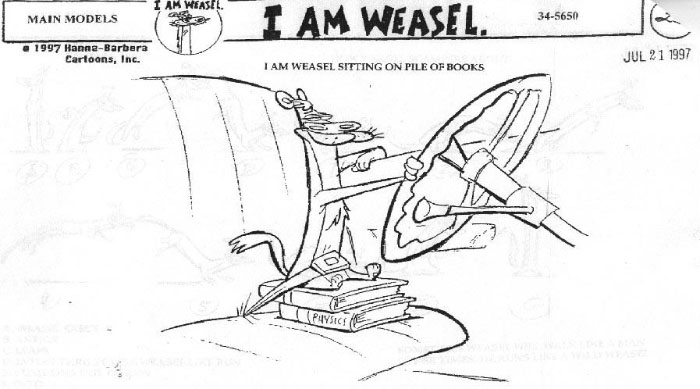
JP: One episode of Cow
& Chicken, “Buffalo Gals”,
was banned because of alleged lesbian subtext. Do you think you
went to far and the network was right to ban it, or do you feel
they were way off base?
DF: Yeah, I did go too far. I would do things differently today.
I was just trying to be silly. That kind of thing is not for
children I think.
JP: I’ve heard of an I Am
Weasel cartoon called “I.R. Good Daddy”
that was never aired because I.R. Baboon had a helmet with an
“M” on it, and the University of Minnesota took
offense. What’s the real story? Does this really exist, and
was it finished? Was it produced when Weasel was a segment on Cow
& Chicken, or was it going to be part
of the Weasel spin-off series (and maybe that’s why it was
only 9 episodes)? Tell me about what happened in the cartoon.
DF: It was actually an "N" because Baboon was living in
his trailer in Nebraska. The university felt it was a put down,
but that was never the intention. The show did air, after the
"N" was digitally removed from each frame at some
expense. In the cartoon, Baboon's biological clock tells him its
time to be a daddy--and he discovers an abandoned baby, whom he
names after his favorite person in the world, his grandpa. So he
raises Baby Grandpa as his own.
JP: I don't see "I Are Good Daddy" in the I Am
Weasel episode guide. Did it air under a different name?
DF: It was called "I Are Mommy."
JP: Are there any other uncompleted or unaired episodes
of Cow & Chicken
or I Am Weasel?
DF: No, all stories that were approved were produced.
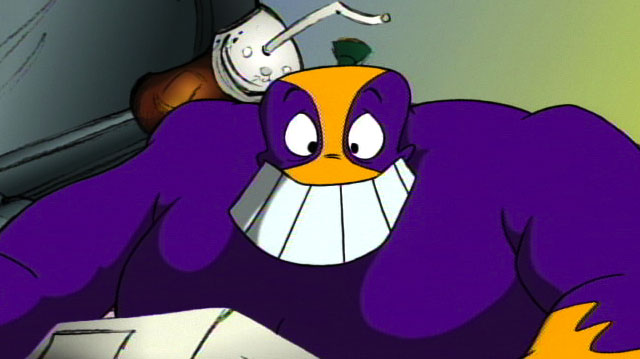
JP: In 2001, there
was an article that
said you had a deal with Wild Brain to produce original content.
Did that pan out like you expected? I know you made commercials
for Cheetos and Kid Cuisine; were there any more?
DF: No--I didn't end up creating original content for them. The
Cheetos commercials were actually made at my own studio, and I
hired Wildbrain for post-production.
JP: Tell me about your work on The
Maxx. I know you worked on issues #5 and
#30 of that book, but were you at all involved with the MTV
animated adaptation? I know Fred Flower and Uncle Italian Moose
were first shown in The Maxx,
and then you tried to bring them into animation; does that mean
you own those characters (and do you own the Crappon in the Hat,
by any chance)? And besides The Maxx,
the Pummeler one-shot,
and some Cow & Chicken-related
cover art, have you done another comics work, even as a amateur
publication?
DF: As I said earlier, Sam and I shared a studio, which ended up
being about 9 years. So Sam had me as a guest in Maxx #5. Crappon
in the Hat is owned by Sam and me, as well as Fred Flower and
Uncle Italian Moose. I was not involved in MTV's adaptation at
all.
That, and the Pummeler thing, is the extent of
my comic career.
JP: I read you were going to make a web cartoon called
Inspector Beaver for Mondo Media, were any episodes of that
actually completed, and if so, were they released online?
DF: I wrote 26-4 minute episodes, and after I left, I think TWO
were produced. I got a call 2 years ago from Mondo Media, asking
if I wanted to produce all of them, but I was too busy to be
involved, so nothing was done.
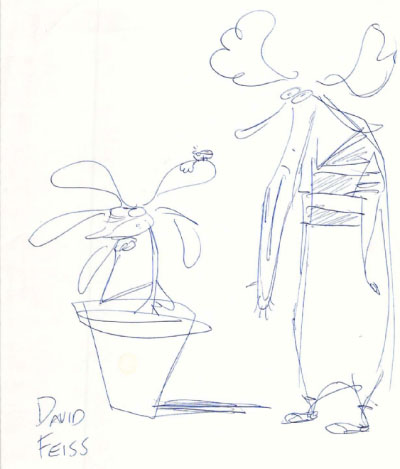
JP: You sort of laid low during most of
the 2000s. Besides commercials, your work at Sony (which we’ll
get too in a moment), and the cartoon you and Michael Fry pitched
to Frederator’s Random Cartoons (“Teddy the Turkey”),
what else did you do in that time period?
DF: I got into features in 2003--I was the Head of Story on the
first Sony animated feature Open Season. After that, I
wrote the short "The Chubb-Chubbs Save Christmas," then
was set up to direct, with Open Season's Tony Stacchi,
for Hotel Transylvania. But that ended abruptly in 2007,
before we could really get started. I was designing the
characters, too. That was a sad time. After leaving Sony, I
directed a pilot for Disney TV, called "Who Shrunk Daniel
Funk," then started working on Astro Boy at Imagi
studios, which was located back at the Sherman Oaks galleria.That
lasted until I landed the "Yoohoo and Friends" job.
JP: Tell me about “Teddy the Turkey”. Did it
get any further in production than storyboard form, if even that?
Were any voice tracks recorded? And tell me about the story and
characters in the cartoon itself? And am I right in assuming that
you and Michael Fry own the rights to the characters and
storyboard/production materials from the cartoon?
DF: Mostly it was Mike's idea. I did the board and design. It
never got any farther than that. I would think that both Mike and
I would own it, but I'm not sure.
JP: Tell me about your work at Sony, Imagi and DreamWorks
Animation? What’s the atmosphere at these places like, and
what are some stories you’d like to share about them? You
were going to co-direct Hotel Transylvania, but didn’t in
the end? What happened, and is the finished film anything like it
would have been if you were still at the helm?
DF: Sony was a blast (It's where I'm back at now). Imagi was very
odd, a strange work situation for sure. DreamWorks was freelance
only, so I never worked on campus.
About Hotel Transylvania--obviously the studio at the
time had other ideas for the film than what Tony and I had
envisioned, and we were replaced. By the time it was finished,
there wasn't much at all from our time on it.
JP: Tell me a little bit about the live-action featurette
you made with Charlie Adler, "No Prom for Cindy."
DF: During production of Cow and Chicken, recordings were once a
week. And after every record, Mike Ryan, Charlie and I would go
to lunch and laugh and generally have a great time. During one of
these lunches, the conversation was about the power of acting,
and specifically, what if something were horribly cast, but
through the power of acting, you could pull it off. That's how
"Cindy" started, with the idea of Charlie, a 40 year
old grey bearded man playing the role of a 14 year old girl.
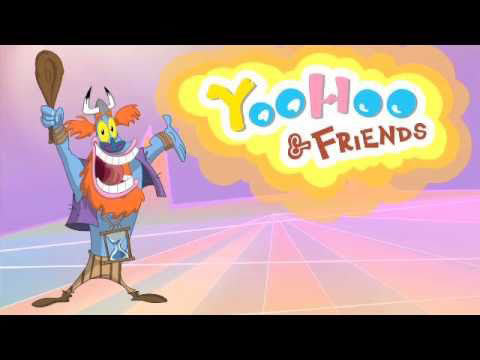
JP: Tell me about work on "YooHoo
and Friends." There were 52 episodes of that show made,
right? Was a larger amount of episodes more difficult to produce?
What’s it like to work with Flava Flav?
DF: After Imagi, I was contacted by Konnie Kwak, the owner of
Toonzone Studios (no relation). She brought me on, and gave me
this Korean kid show "Yoohoo and Friends" which she had
acquired the rights to. She wanted me to make this really young
Korean language kid show into something that she could sell to
western TV. The style wasn't my style at all, and at first I was
worried about what I could do with it. But then it occurred to me
that if I approached it similarly to Woody Allen's "What's Up,
Tiger Lily," where a foreign language film is redubbed in
english with an entirely different story, it could be funny. I
proposed taking the existing 11 minute Korean shorts, and
rewriting the dialogue, and creating 4 minutes of new animation
per episode (cutting out 4 minutes of old footage). I created a
brand new story arc, back story, etc…
The original Korean show revolves around these 5 super-cute animals who travel the world, meeting new cute characters, and recovering a gem. So my new idea was this: before they were super cute animals, they were Corporate Executives, who were destroying the world through their greed and negligence. This got the attention of Mother Nature, who was pissed off at this damage to her world. And Mother Nature happens to be married to Father Time (Flava Flav) , a time-traveling ogre with a magic club that he carries. Mother Nature commands Father Time to talk to these executives, and try to convince them to stop their destructive ways. They ignore him--so he then turns each executive into one of the corresponding cute furry animals who happens to resemble each exec. There mission: To go around the world, and fix the mess they made as greedy executives. After they have completed their mission, and find a Father Time hidden gem at each place, he will turn them back into executives.
Working with Flava Flav was awesome. He's a great guy. I met Flav by moving into a house across the street from him! We became friends, and that's how I got him involved in "Yoohoo and Friends."
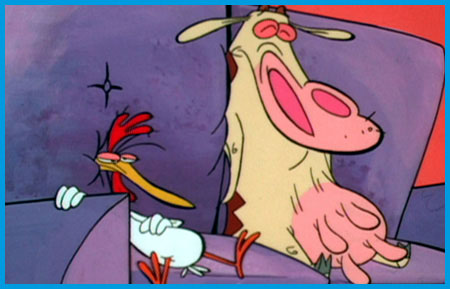
JP:You’re cousins with Sam Kieth,
and your ex-wife Pilar had an art exhibit in France. What are
some of your family’s other accomplishments?
DF: My wife AnneMarie used to work in the industry back before
all these kids! She was very involved with Spumco, working as a
flash animator on Ren and Stimpy, as well as other
productions John was producing.
JP: Where are you working now, and are you at liberty to
mention any projects you’re working on? Any chance of you
directing a feature, or at least more shorts in the foreseeable
future?
DF: I’m happily back at Sony--I just finished directing 4
short mini-movies for the DVD of Cloudy With A Chance Of Meatballs
2. I have developed a feature here, but I don't know whether
or not it will go. Meanwhile, I am working on other feature ideas
that I would like to get off the ground here.
JP: And finally, is there any advice you want to give to
young people who want to work in the animation industry?
DF: Obviously the industry has changed quite a bit from when I
started, without the opportunity to be an assistant animator as
an entry level job. I think that taking college courses in
animation are a good idea--it seems most of the young people who
I see around me are quite a bit more advanced than I was at the
same age, and I think they learn their skills in school. More
advice would be to draw all the time, study artists that you
like, try and draw like them. That's really a good way to learn.
RETURN TO THE MAIN PAGE
OR,
CHECK OUT THESE LINKS FOR MORE QUESTIONS AND ANSWERS
David Feiss Talks Making 2-D Short Cartoons At Sony Pictures Animation | Animation Scoop
David Feiss
Meet Charlie Adler, The New King of Voice Actors - Mania.com
CLICK HERE FOR AN UPDATE TO THIS INTERVIEW